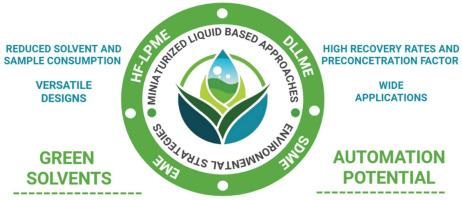用于环境分析的小型液体样品制备技术的进展:绿色溶剂和自动化的特别展望
IF 3.2
引用次数: 0
摘要
农业和工业实践的不断进步导致在关键生产部门广泛采用各种化学品。虽然这些物质具有显著的益处,但处置不当导致其在环境隔间中积累,引起全球对其对生态系统和人类健康的潜在影响的关注。在定量和定性分析中,液体小型化技术已被广泛应用于这些基质,以确保环境样品中这些化合物的检测和定量。它们的许多优点都植根于绿色分析化学的关键原则,例如减少样品和溶剂消耗,以及它们在实现不同提取设计方面的多功能性。然而,传统有机溶剂的使用和劳动密集型的提取程序仍然限制了这些技术在环境应用中的全部潜力。因此,本综述综述了目前小型化液相萃取技术在环境分析中的应用,重点介绍了创新方法。此外,我们讨论了绿色溶剂的使用和这些方法自动化的潜力。通过这一综述,我们旨在鼓励研究人员采用小型化液体技术进行环境监测,从而促进更可持续和高效的分析策略的实施。本文章由计算机程序翻译,如有差异,请以英文原文为准。

Advances in miniaturized liquid sample preparation techniques for environmental analysis: A special look towards green solvents and automation
The continuous advancements in agricultural and industrial practices have led to the widespread introduction of various chemicals across key production sectors. While these substances offer significant benefits, their improper disposal has led to their accumulation in environmental compartments, raising global concerns about their potential impacts on ecosystems and human health. In quantitative and qualitative analysis, liquid miniaturized techniques have been widely applied to these matrices to ensure the detection and quantification of these compounds in environmental samples. Many of their advantages are rooted in key principles of green analytical chemistry, such as reduced sample and solvent consumption, as well as their versatility in enabling diverse extraction designs. However, the use of conventional organic solvents and labor-intensive extraction procedures still limits the full potential of these techniques in environmental applications. Hence, the present review provides an overview of current applications of miniaturized liquid-phase extraction protocols in environmental analysis, highlighting innovative approaches. Moreover, we discuss the use of green solvents and the potential for automation in these methods. Through this review, we aim to encourage researchers to adopt miniaturized liquid techniques for environmental monitoring, thereby advancing the implementation of more sustainable and efficient analytical strategies.
求助全文
通过发布文献求助,成功后即可免费获取论文全文。
去求助
来源期刊

Journal of chromatography open
Analytical Chemistry
CiteScore
2.50
自引率
0.00%
发文量
0
审稿时长
50 days
 求助内容:
求助内容: 应助结果提醒方式:
应助结果提醒方式:


